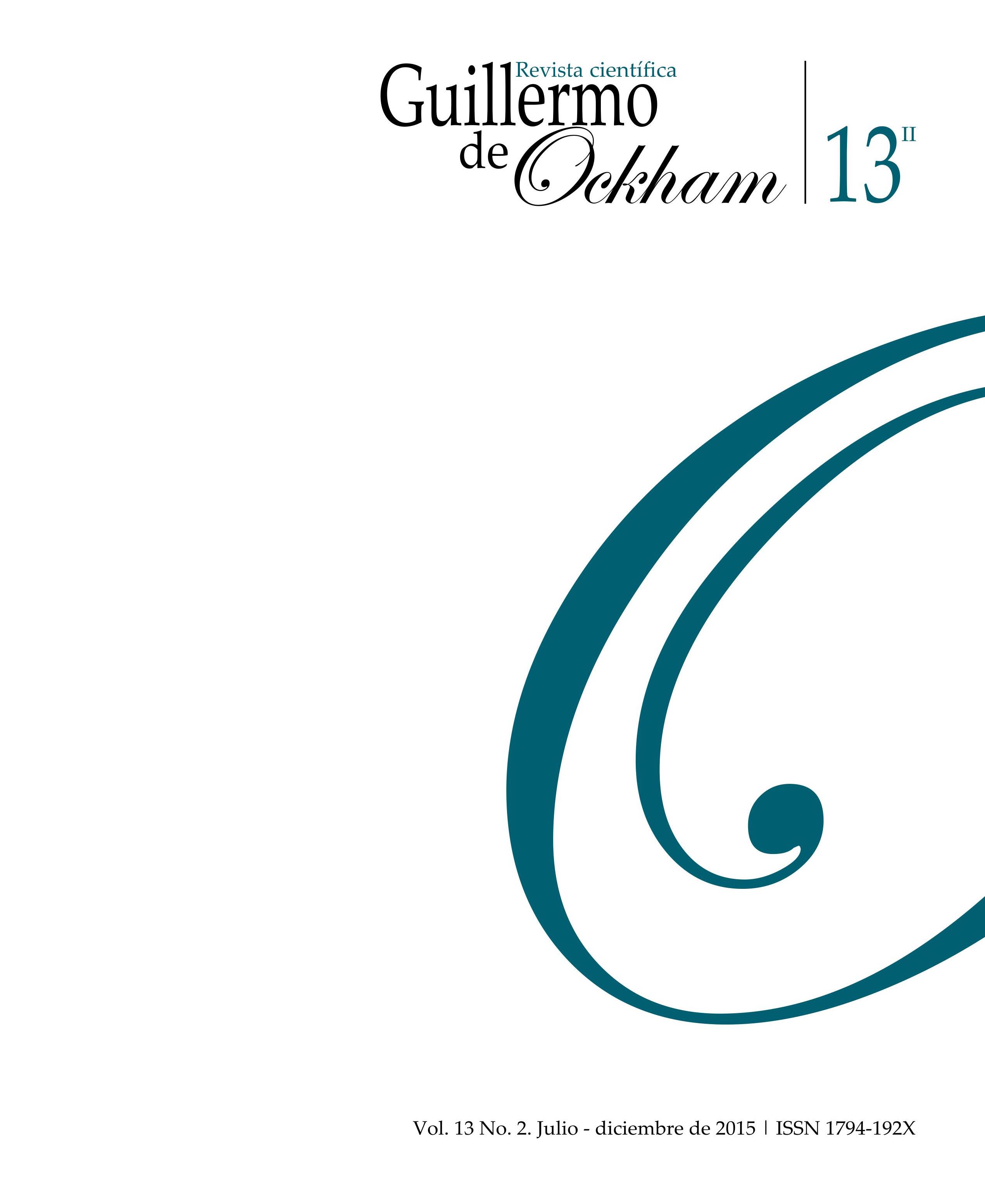The Revista Guillermo de Ockham provides an immediate and open access to its content, based on the principle of offering the public a free access to investigations to provide a global interchange of knowledge.
Unless otherwise established, the contents of this journal has a license with Creative Commons Attribution-NonCommercial-NoDerivatives 4.0 International (CC BY-NC-ND 4.0) http://creativecommons.org/licenses/by-nc-nd/4.0/
- Attribution: You must give appropriate credit, provide a link to the license, and indicate if changes were made. You may do so in any reasonable manner, but not in any way that suggests the licensor endorses you or your use.
- NonCommercial: You may not use the material for commercial purposes.
- NoDerivatives: If you remix, transform, or build upon the material, you may not distribute the modified material.
- No additional restrictions: You may not apply legal terms or technological measures that legally restrict others from doing anything the license permits.
Resumo
Referências
Baesler, J. E., & Lauricella, S. (2014). Teach peace!: Assessing instruction of the nonviolent communication and peace course. Journal of Peace Education, 11, 1, 46-63.
Bar-Tal, D. (2002). The elusive nature of peace education. En G. Salomon & B. Nevo (Eds.), Peace education: The concepts, principles, and practices around the world (pp. 27-36). Mahwah, NJ: Lawrence Erlbaum Associates.
Clarke-Habibi, S. (2005). Transforming Worldviews: The Case of Education for Peace in Bosnia and Herzegovina. Journal of Transformative Education, 3(1), 33-56.
Danesh, H. B. (2008). The education for peace integrative curriculum: Contents, concepts, and efficacy. Journal of Peace Education, 5(2), 157-174.
Danesh H. B., & Danesh, R. P. (2002a). Has conflict resolution grown up?: toward a new model of decision making and conflict resolution. International Journal of Peace Studies, 7(1), 59-76.
Danesh H. B., & Danesh, R. P. (2002b). A consultative conflict resolution model: beyond alternative dispute-resolution. International Journal of Peace Studies, 7(2), 17-33.
Danesh, H., B., & Danesh, R. (2004). Conflict-free conflict resolution (CFCR): process and methodology. Peace and Conflict Studies, 11(2), 55-84.
Davies, L. (2005). The edge of chaos: explorations in education and conflict. En J. Zajda (Ed.), International Handbook on Globalisation, Education and Policy Research (pp. 631-642). Springer: The Nederlands.
Declaración Universal de los Derechos Humanos. (1948). Resolución de la Asamblea General 217A (III) del 10 de diciembre 10, 1948; U.N. Doc A/810, 71 (1948), Artículo 26.
Galtung, J. (1975). Peace: Research, education, action. Essays in Peace Research. Copenhagen: Christian Ejlers.
Galtung, J. (1988). Peace and social structure. Essays in Peace Research. Copenhagen: Christian Eljers.
Galtung, J. (1996). Peace by peaceful means: Peace and conflict, development and civilization. Londres: Sage.
Galtung, J. (2004). Trascend and Transform an Introduction to Conflict Work. Londres: Pluto Press.
Galtung, J., & Jacobsen, C. G. (2000). Searching for Peace: the Road to Transcend. Londres: Pluto Press.
Groff, L., & Smoker, P. (1996). Creating global/local cultures of peace. En UNESCO, From a culture of violence to a culture of peace (pp. 103-128). Paris: UNESCO.
Harris, I., & Morrison, M. (2003). Peace Education. Jefferson, NC: McFarland & Co.
Harris, I., & Synott, J. (2002). Peace education for a new century. Social Alternatives, 21(1), 3-6.
Hicks, D. (2004). Teaching for tomorrow: How can future studies contribute to peace education? Journal of Peace Education, 1(2), 165-178.
Isumonah, V. A. (2005). Problems of peacemaking and peacekeeping. En Albert, I. O. (Ed.), Perspectives on Peace and Conflict in Africa (pp. 198-216). Ibadan: Peace and Conflict Studies Programme.
Johnson, D., Johnson, R., & Tjosvold, D. (2000). Constructive controversy: the value of intellectual opposition. En M. Deutsch & P. T. Coleman (Eds.), The Handbook of Conflict Resolution: Theory and Practice (pp. 65-85). San Francisco, CA, Jossey-Bass.
Kester, K. (2012). Peace Education Primer. Journal of Global Citizenship & Equity Education, 2(2), 62-75.
Kester, K. (2013). Peace education: an impact assessment of a case study of UNESCO-APCEIU and the university for peace. Journal of Peace Education, 10(2), 157-171.
Kester, K., & Booth, A. (2010). Education, peace and Freire: A dialogue. Development, 53(4), 498-503.
Korostelina, K. V. (2012). Introduction. En K. V. Korostelina (Ed.), Forming a Culture of Peace. Reframing Narratives of Intergroup Relations, Equity, and Justice (pp. 1-14). NY: Palgrave Macmillan.
López-Noguero, F. (2005). Metodología participativa en la Enseñanza Universitaria. Madrid: Narcea.
Lum, J. (2013). Peace education: past, present, and future. Journal of Peace Education, 10(3), 215-229.
Asmal, K., Chidester, D., & James. W. (2004). Nelson Mandela. In His Own Words. From Freedom to the Future. Lancaster: Abacus.
Martínez-Lirola, M. (2013). Ejemplos de la relación entre el aprendizaje cooperativo y la adquisición de competencias interpersonales en una clase de lengua inglesa. Encuentro Revista de investigación e innovación en la clase de idiomas, 22, 73-83.
Muñoz, F. (2004). Manual de Paz y Conflictos. Granada: Universidad Granada.
Oyesola, D. (2005). Environmental Degradation and Peace Studies. En I. O. Albert (Ed.), Perspectives on Peace and Conflict in Africa (pp. 253-267). Ibadan: Peace and Conflict Studies Programme.
Page, J. S. (2004). Peace Education: Exploring Some Philosophical Foundations. International Review of Education, 50(1), 3-15.
Page, J. S. (2008). Peace Education: Exploring Ethical and Philosophical Foundations. Charlotte: Information Age Publishing.
Rué, J. (2007). Enseñar en la Universidad. El EEES como reto para la Educación Superior. Madrid: Narcea.
Salomon, G. (2002). The nature of peace education: Not all programs are created equal. En G. Salomon & B. Nevo (Eds.), Peace education: The concepts, principles, and practices around the world (pp. 3-14). Mahwah, NJ: Lawrence Erlbaum Associates.
Salomon, G., & Cairns, E. (2010). Handboook on Peace Education. NY: Taylor & Francis.
Salomon, G., & Cairns, E. (2010). Peace education. Setting the scene. En G. Salomon & E. Cairns (Eds.), Handbook on Peace Education (pp. 1-7). NY: Taylor and & Francis.
Salomon, G., & Nevo, B. (2002). Peace Education: The Concept, Principles and Practices around the World. Mahwah, NJ: Lawrence Erlbaum.
Sandy, S. (2001). Conflict resolution in schools: "Getting there". Conflict Resolution Quarterly, 19, 2, 237-250.
Simon, E., & Pleschová, G. (2013). Teacher Development in Higher Education. Existing Programs, Program Impact, and Future Trends. Londres/Nueva York: Routledge.
Tal-Or, N., Boninger, D. & Gleicher, F. (2002). Understanding the Conditions and Processes Necessary for Intergroup Contact to Reduce Prejudice. En G. Salomon & B. Nevo (Eds.), Peace Education, The Concept, Principles, and Practices Around the World. (pp. 89- 108). Mahwah, NJ: Lawrence Erlbaum Associates Publishers.
Timpson, W. (2002). Teaching and Learning Peace. Madison, WI: Atwood Publishing.































